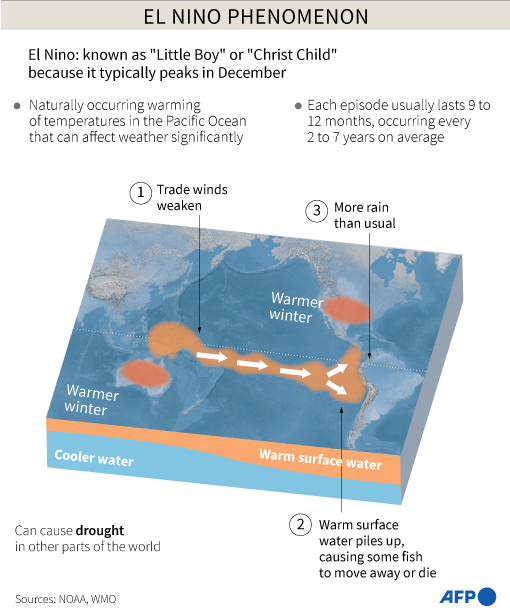
TOKYO - Japan's weather bureau said on Friday there was a 90 percent chance that the El Nino phenomenon will dissipate by the end of May, while there was a 60 percent chance of the La Nina phenomenon occurring in the months up until November.
El Nino is a warming of ocean surface temperatures in the eastern and central Pacific. La Nina is characterized by unusually cold ocean temperatures in the equatorial Pacific region and is linked to floods and drought.
The US National Weather Service's Climate Prediction Center also said that the El Nino weather pattern should fade out by June but could be replaced by the La Nina phenomenon by the second half of the year.
Experts have warned that Latin American nations must be on high alert as a rapid switch to La Nina this time could leave populations and crops little time to recover
There is a 49 percent chance that the La Nina weather pattern may develop during the June to August period, rising to 69 percent in July-September, the CPC said in its monthly forecast on Thursday.
ALSO READ: South America weather experts see La Nina, El Nino frequency rising
The cycle between the weather patterns -- which can spawn wildfires, tropical cyclones and prolonged droughts -- is vital to farmers worldwide.
In Latin America, they have affected crops such as wheat, soy and corn, damaging regional economies often highly dependent on farming.
Hot, dry weather in Asia during El Nino last year prompted top rice supplier India to restrict exports following a poor monsoon, while wheat output in No 2 exporter Australia took a hit. But heavier rains in parts of the Americas boosted farm output prospects in Argentina and the southern US Plains.

The full weather pattern involving El Nino, La Nina and a neutral phase typically lasts between two to seven years.
Experts have warned that Latin American nations must be on high alert as a rapid switch to La Nina this time could leave populations and crops little time to recover.
Australia's weather bureau said last month that the El Nino event has ended.
READ MORE: Australia's weather bureau says El Nino has ended, unsure about La Nina
"La Nina is likely to affect the production of wheat and corn in the US, and soybean, barley, wheat and corn in Latin America including Brazil, Argentina and Uruguay," said Sabrin Chowdhury, head of commodities at BMI.

"The weather phenomenon is associated with long-lasting droughts throughout the Americas region, triggering poor crop quality and a drop in average yields, further exacerbating global supply issues."


